VaxStation 2000
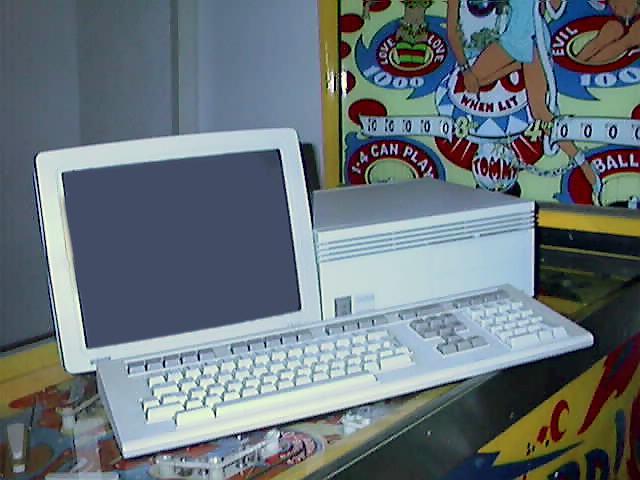
The VS2000 is a small and somewhat slow "VAX in a lunch box". It is great for the beginner to experiment with, not as noisy and not as big as other VAX systems. It will run VMS, Ultrix and NetBSD, and it is possible to hook a graphical monitor up to it.
VAXstation/microVAX jumper
The MicroVAX 2000 and the VAXstation 2000 really are the same machine. You can set a jumper on the system board to tell the system how to behave.
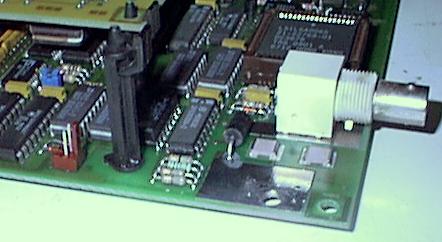
On the KA410 motherboard about two inches or so directly behind the thin ethernet BNC connector:
- VAXstation 2000: jumper on pins closer to thin ethernet BNC
- MicroVAX 2000: jumper on pins farther away from the thin ethernet BNC
A blue jumper was used for the picture, so you could see it more easily here, but the original jumper is black.
There are four serial ports on the cpu board. On the MicroVAX 2000, these become the console and three terminal ports. On the VAXstation 2000, these become the printer port, keyboard, mouse and modem interface.
Both machines have a mono (1024x864x1) frame buffer on the CPU board. You enable or disable it (read: change it from a MicroVAX 2000 to a VAXstation 2000 and back) by inserting or removing the jumper.
Also this jumper toggles a flag in the configuration register (the "server flag") which is checked by some VAX/VMS software in order to decide which and how many licenses you need. This flag is used by NetBSD only to decide which string to diplay, "MicroVAX 2000" or "VAXstation 2000"
Console cable
If the graphics board has been disabled with the jumper, the console is switched to the printer port. However, to get the console to appear on the printer port, setting the jumper is not required. It is possible to force a VS2000 to use a serial console without fiddling with the jumper on the motherboard.
The 2000 has four serial ports: the 25-pin comm port, the 9-pin printer port, and two ports on the 15-pin video port for the mouse and keyboard. Normally, to connect a printer to the 9-pin printer port you use a BCC05 cable. If you use a BCC08 cable, the 2000 will use the 9-pin port as its console. The BCC08 shorts pins 8 and 9 of the 9-pin port together to signal it should be used as a console. The other interesting pins on the 9-pin port are:
1 - Shield GND 2 - Transmitted data 3 - Received data 7 - Signal GND
This is the console cable:
VAX 9 pin console PC 9 pin serial PC 25 pin serial
1 - Shield GND 2 - Received data 1 - Shield ground
2 - Transmitted data 3 - Transmitted data 2 - Transmitted data
3 - Received data 5 - Signal GND 3 - Received data
7 - Signal GND 1 - DCD 7 - Signal GND
8 - sense console 1 4 - DTR 8 - DCD
9 - sense console 2 6 - DSR 20 - DTR
7 - RTS 6 - DSR
8 - CTS 4 - RTS
5 - CTS
The cable
VAX PC9 PC25
2 --------- 2 3
3 --------- 3 2
7 --------- 5 7
8 -+ +- 1 8
| |
9 -+ +- 4 20
|
+- 6 6
+- 7 4
|
+- 8 5
Do not forget to short pins 8 and 9 on the VAX side, for some VS2000s this is required to make the console work, regardless of the setting of the jumper.
Connectors on the system board

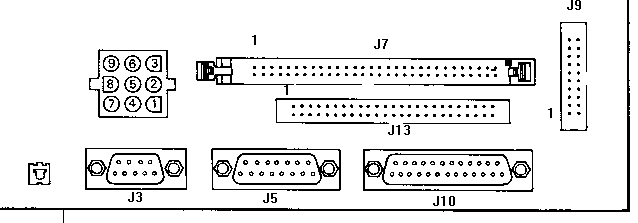
Printer/console port (J3) 1 - ground 2 - xmit_data 3 - rcv_data 4 - no conn 5 - +12VDC 6 - no conn 7 - ground 8 - ground 9 - fer_ena (jumper to pin 8 for console) Video Connector (J5) 1 - vid_red 2 - color_ret 3 - mono_ret 4 - +5VDC 5 - mouse_rcv 6 - kbd_grnd 7 - ground 8 - +12VDC 9 - vid_mono 10 - vid_green 11 - vid_blue 12 - -12VDC 13 - mouse_xmit 14 - kbd_rcv 15 - kbd_xmit The interesting pins in the video connector from a serial port perspective are: 6 - GND for keyboard 14- Received data from keyboard 15 - Transmitted data to keyboard 7 - GND for mouse 5 - Received data from mouse 13 - Transmitted data to mouse There is a plastic box about the size of a cigarette pack that plugs into the db9 printer port and db15 keyboard/mouse/video cable connector and screws into place outside the main chassis. It takes over that db9 and db15 and gives you three DECconnect (MMJ) connectors for terminal ports for the MicroVAX 2000 configuration. It is possible (if you have the connectors lying around) to build cables to break out the serial ports without needing the DEC box. Just use the pinouts described above.
Comm Connector (J10) - RS232 with partial modem control
This is a standard 25-pin serial port.
Tape Port Connector (J13) - single ended SCSI
This connector has the standard 50-pin SCSI-1 pinout.
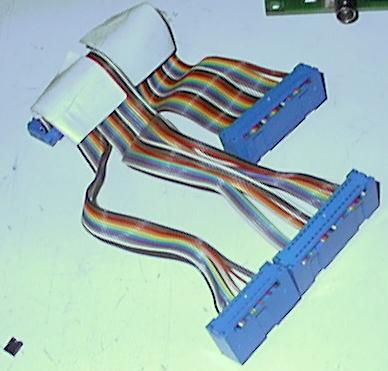
RD/RX Cable Pinout (J7)
1,3,5,7,9,11,13,15,17,19,21,23,25,27,31,34,37,40,43,46,48,51,54,57,60 - ground 2 - lospeed 4 - rxindex 6 - rxsel0 10 - moron 12 - rxdir 14 - rxstep 16 - rxwd 18 - rxwrgt 20 - rxtk00 22 - wrtprot 24 - rxrdata 26 - rxhsel0 28 - rxrdy 29 - rdhsel3 30 - rdhsel2 32 - rdwrgt 33 - skcompl 35 - rdtk00 36 - wrtfault 38 - rdhsel0 39 - rdhsel1 41 - rdindex 42 - rdrdy 44 - rdstep 45 - rdsel0 47 - rdsel1 49 - rddir 50 - dselack 55 - rd0_wdath 56 - rd0_wdatl 58 - rd0_rdath 59 - rd0_rdatl 8,52,53 - no conn Expansion Disk Data Cable (J9) 2,4,6,8,11,12,15,16,19 - ground 3,5,9,10,20 - no conn 1 - dselack 7 - +5Vdc 13 - rd1_wdath 14 - rd1_wdatl 17 - rd1_rdath 18 - rd1_rdatl
MFM Hard disk connectors
The other end of the cable must have this pinout: Hard disk 34 pin connector 4 - head select 2 6 - write gate 8 - seek complete 10 - track 0 12 - write fault 14 - head select 0 18 - head select 1 20 - index 22 - ready 24 - step 26 - drive select 1 28 - drive select 2 30 - drive select 3 32 - drive select 4 34 - direction in 1-33 ground (odd numbers) 2,16,30,32 reserved Hard disk 20 pin connector 1 - drive selected 5 - key 13 - +mfm write data 14 - -mfm write data 17 - +mfm read data 18 - -mfm read data 2,4,6,8,10,11,12,15,16,19,20 ground 3,5,7,9 reserved all other pins unused. Floppy drive 24 pin connector 2 - mode select 4 - in use 6 - drive select 3 8 - index 10 - drive select 0 12 - drive select 1 14 - drive select 2 16 - motor on 18 - direction select 20 - step 22 - write data 24 - write gate 26 - track 0 28 - write protect 30 - read data 32 - side 1 select 34 - ready/disk change/open 1-33 ground (odd numbered pins)
Building a replacement cable
With the pin numbering information above you should be able to build a new cable. Problem is that there are less wires going to the disk connectors than there are pins in the connectors, so while putting the cable in the connector you are going to have to skip pins, as you can see in the pictures.
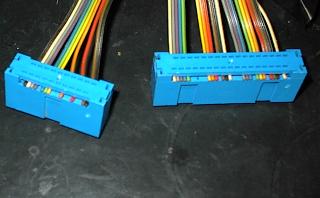
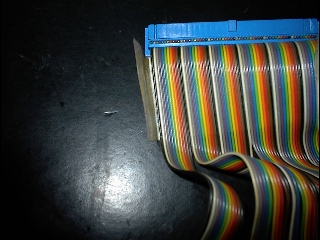
19 2 34 2 XOOOOXOOOXXXOXXOXXOO OOOOOXXXXXOOOX000XXXOOOX000XOOOXOX 20 1 33 1
This is where the wires should be on the hard disk connectors.
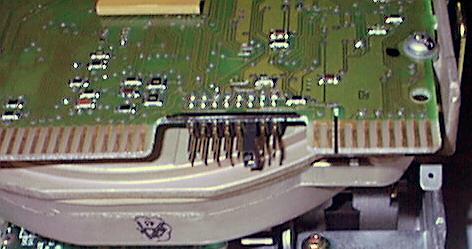
This is where the jumper on the RD32 hard disk should be, jumpered as the third of four drives.
The floppy drive should be jumpered as ID0, the first drive.
Formatting the hard disk
It is very useful to have a VS2000 around, if only to format hard disks with. For a MFM hard disk to work in a MicroVAX it must have a very peculiar format written to it. The VS2000 and the Q-bus RQDX3 controller for the MicroVAX II et al require this format to be present. The VS2000 is the only DEC device that can write this format without expensive hard to get software: the formatter is present in the VS2000 ROM under the TEST 70 command. If the formatting of a disk you are using on a RQDX controller is damaged, you can format the disk in a VS2000 and hook it back up to the RQDX controller, the disk will work like new. Click on this link to read how to format a disk in the VS2000.
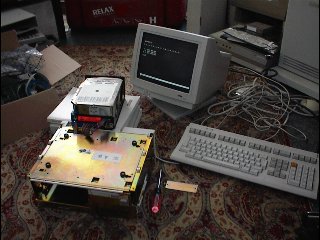
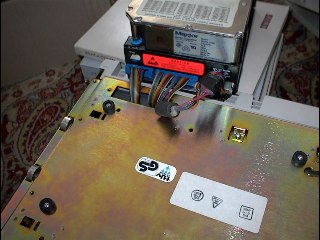
This is how I format hard disks with my VS2000. I have brought the existing cables to the outside of the box via the opening that is there to connect the expansion unit to the computer. Just remove the plate and you can pull the cables through it. Very easy!
Thanks
Thanks to Dave McGuire (mcguire@digex.net), Rick (rick@snowhite.cis.uoguelph.ca), Roger Ivie (ivie@cc.usu.edu), Bertram Bach (), whose posts to the NetBSD/VAX mailing list provided much of the above info.

